2014-11-25 By Robbin Laird
Both the UK and Italy will operate a mixed Eurofighter and F-35 fleet. Both have operated the Tornado, which is reaching the end of its service life. Both will sort through evolutions of the Eurofighter to encompass some of the mission sets for Tornado as the Tornado is retired and as the F-35 comes into the two fleets and provides the next surge for the re-working of air-led combat concepts of operations.
A key element of this transformation will be reworking the connectivity among air, sea and ground systems as well as shaping the weaponization approaches of joint and coalition forces.
In part, this is a Eurofighter transition whereby the radars are upgraded, and weapons added; in part this is the coming of the F-35 and its impact on reshaping air enabled combat operations.
And associated with this will be fundamental changes over time in C2, and the approach to strike operations.
The UK and Italy already fly together in operations through their use of Tornados and Eurofighters and have clearly shared combat learning with regard to the use of these platforms; as the F-35 comes on line this combat learning cycle will continue into the next generation of aircraft, and shaping ways to approach fifth generation warfare.
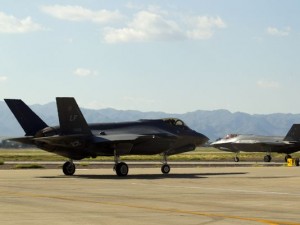
In effect, the dynamics of change for Italy and the UK will be a function of the intersection of four variables: the evolution of the Eurofighter; the impact of the F-35 and the global fleet of F-35s; changes in weaponization, and evolving C2 for strike and combat operations.
There is an inherent possibility that the UK and Italy could provide an important force for synergy in shaping concurrent approaches to evolving concepts of operations. Of course, this depends upon how effective their working relationship is and how effective cross-MOD, and cross-industrial relationships are in leveraging their working relationship.
And the two countries can play an important role as well with the European Air Group, the only multinational organization which focuses solely on airpower and its evolution. Recently, the EAG which has been a fundamental element of shaping the European Air Transport Command and the soon to be stood up European Personnel Recovery Centre, has started to look for the Air Chiefs of the seven European Air Forces for whom they work at the integration of 4th and 5th generation aircraft.
Clearly, Italy and the UK can play an important role working through the challenges and the opportunities based on the evolution of Eurofighter while the F-35 is introduced.
And both will be operating F-35Bs from sea bases so can lead in shaping an understanding of how sea-based and land-based air can work together to great a significant operational effect as well.
The Reconfiguration of Eurofighter
The twin dynamics of the retirement of the Tornado and the arrival of the F-35 pose a significant challenge as well as opportunity for both the UK and Italy.
And shaping effective responses to this challenge can open prospects of innovation for other Eurofighter users as well.
Although operational needs have kept moving the Tornado retirement date to the right, the scheduled date is 2019 for the RAF.
Italy will be a bit further down the road and retire their Tornados with 5 years after the intended RAF retirement date.
As one UK Typhoon pilot put it in a recent interview to appear shortly; “There is a clear need to expand the effects of Typhoon operations and here the enhancement of its weapons package will be an important improvement.”
To take up some of this role the Eurofighter is being reconfigured to provide an enhanced capability for the ground attack role, over and above the austere level of Enhanced Paveway II integration that was used by the RAF during the Libya campaign.
Paveway 4 is being integrated in P1E and then further weapon capability, primarily from MBDA, is being integrated, some of which are currently carried by Tornado.
The Tornado carries both Storm Shadow and Brimstone and both are being shaped for integration onboard the Eurofighter. The integration of the Storm Shadow on Typhoon is being driven in part by funding from the Middle East, notably Saudi Arabia which wants its Typhoons to have a cruise missile carrying capability, and when married with its new air tanking capability can enhance the strike range of its Typhoon force.
Brimstone 2 is designed to operate against maneuvering surface targets on land or sea. It is a low collateral, close air support weapon and has been combat proven by the RAF in both Afghanistan and Libya. It will greatly enhance the effect of the Eurofighter as well.
And a recently announced modernization package for the Eurofighter radar will allow the integration of Storm Shadow and Brimstone 2 to be more effective as well.
As Alan Tovey in the Daily Telegraph highlighted the synergy between weapons modernization and radar upgrades:
The new radar will increase the range at which Typhoon pilots can identify potential targets, as well as allowing them to scan a 200-degree field of vision, greater than rival fighters, giving them a tactical advantage.
The addition of the radar will take Typhoon’s capabilities ahead of other fourth-generation fighters such as France’s Rafale and Sweden’s Gripen, making it more attractive to export clients looking to upgrade their air forces.

In many ways, the pressure on Eurofighter is to indeed redeem its promise as a multi-role fighter and to be able to expand its effects, to quote the Typhoon pilot and future station commander cited earlier.
For the plane will evolve over time, into a significant role as well a weapons caddy for the F-35 enabled Italian and British strike forces.
The RAF has already caught a glimpse of what 5th generation aircraft can do for its Typhoons in training with the F-22s. The experience of training at Langley AFB was quite clear: and to quote the Typhoon pilot: “The situational awareness of the F-22 enhanced our survivability and lethality.”
And this pilot saw a future where the hard points on the Typhoon can evolve over time in terms of what it carries to support an initial fifth generation insertion fleet.
The Impact of the F-35 Fleet
The F-35 is built from the ground up to be a 21st century multi-mission aircraft.
In the words, of Rear Admiral Manazir, the head of USN Air Warfare:
“The F-35 is not an A (Attack) or an E (Electronic Warfare) or an F (Fighter); it is all of those. Earlier we had an F-14, an A-6 and an EA-6B and needed all three to do our job; now one airplane blends those capabilities and we can leverage that as we look at the integration of the other capabilities of the air wing we are developing.
Fifth generation is opening up so many possibilities that how we used to think about our capabilities is changing; how do we wring out the full capabilities of the air wing with the fifth generation as a catalyst for change?
Where it used to be platform-to-platform, we now have inherent in a single weapon system, the capability to fold in all those things that we used to think were single missions, like the fighter mission, like the attack mission, like the electronic warfare mission.
Those missions were given to separate platforms because we didn’t have the way to fold them into a single platform. Now we have that capability to do that. So that fundamentally causes us to look at the way in which we do business in the future.”
The F-35 will function as a forward scout, a passive sensor strike force, a forward battle management fleet, and generally operate in ways, which will enable the rest of the strike forces to operate much more effectively.
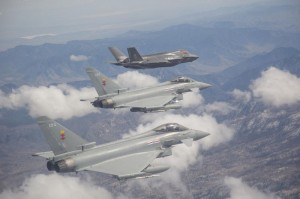
As the head of the Italian Air Force, Lt. General Preziosa, has put it with regard to the impact of the F-35 on his legacy fleet:
“One way to think about the way ahead is to continue to use 4th generation aircraft in surging mass to more classic airpower situations. One would use the F-35 as the key asset up against the distributed operational settings or for operations in denied air space. Another way to look at it will be to find ways to gain more synergy between the F-35 and the legacy fleet. How can we better utilize our older assets during the process where the F-35 fleet becomes a reality?
Shaping combinations of 4th generation with the F-35s will be a mix and match opportunity in tailoring airpower to the missions ahead.
This is a challenge; but it is a key task within which the F-35s will make the legacy aircraft more effective; and the 4th generation aircraft will add support and strike capabilities to an F-35 enabled air power force.”
He then added that when he was speaking of airpower, he was not simply speaking to the question of an air force.
All of the services are enabled by airpower.
“The Navy is not defined by its ships but by its operational reach and this comes with airpower. The Army tends to think of airpower in terms of their helicopters, but Afghanistan teaches a different lesson. Continents are working together; why not the services?”
He concluded by emphasizing that the line between those countries that operate in the fifth generation and those that don’t will be more than just a line in the sand.
“It will first of all be about survival. Do you want to be the Eagle or the Chicken in an airpower confrontation?
Working New Concepts of Operations
This puts an innovative challenge in front of the UK and Italian Air Forces – how best to work the relationships with a Eurofighter transitioning to a role in ground attack while the F-35 enables air and sea bases to operate with greater reach by linking up with the global fleet of F-35s?
USMC and USN airpower leaders have both highlighted the importance of the F-35 fleet aspects in enhancing the range of the sea base, and its ability to work more effectively with land-based air assets. With the F-35Bs coming off of the amphibious fleet, the reach of the F-35Bs is enhanced by its integration with allied and joint F-35s sharing data, and decision-making.
This is a key enabler for the tiltrotar enabled assault force, which comes off of todays’ amphibious ships.
It is also a consideration when looking at the USN carrier fleet and notably when the USS Ford is added to the force.
As Rear Admiral Manazir put it clearly:
“Reach not range is a key aspect of looking at the carrier airwing and its ability to work with joint and coalition forces. This is clearly enhanced with the F-35.
What you can do with a Carrier, given joint and coalition perspectives is the Carrier automatically extends your reach because you can put it anywhere you want. The mobility of the carrier is a key point. You can put it up against the problem set the national command authority or the joint force commander wishes to address; and then you can move it to deal with an evolving target or operational set of challenges, again aligned with the commander’s intent.
You can move the reach of the carrier wing as you redeploy it and connect with joint or coalition assets. The carrier has a core ability to operate organically but its real impact comes from its synergy with the joint and coalition force, which will only go up as the global F-35 fleet emerges.”
For the British and Italians, the ability of the F-35 to tie in the sea base with land-based operations is an important consideration, as F-35Bs will fly off of the new Queen Elizabeth class carriers, as well as off of the smaller Italian carriers, more akin to the USN amphibious ships. Indeed, British strategic planners are already trying to think through the cross cutting of a new large aircraft carrier with a fifth generation strike capability which can allow aircraft on the seabase to integrate other at sea assets with land based ones.
A graphic contained in the May 2013, Carrier Strike Report from the National Audit Office, reflects some of the initial thinking:
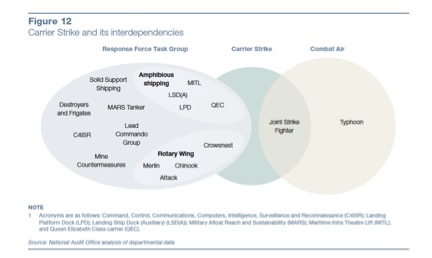
Eurofighters forward deployed on land bases and operationally integrated with the F-35s can provide a lethal expansion of the strike capability of the overall force as the F-35 prioritizes targets and identifies strike support which the Eurofighters can provide as weapons carriers and launchers.
Shaping such integrated concepts of operations will require technological changes as well as cultural changes.
The technical changes will be easier than the cultural ones, for sure.
The technical dynamic is already under way in working F-22 relationships with the legacy fleet for the USAF.
As then head of the ACC, General Mike Hostage put it:
I have got the command embarked on a full-court press to get a fourth to fifth, fifth to fourth capability that will need a combat cloud to be fully empowered, but it will then allow us to fundamentally change how the fourth generation platforms fight in addition to the fifth gen.
Without that back and forth communication, machine-to-machine, the fourth gen’s going to have to do what they already do, they’ll just leverage some of the capability that fifth gen — the SA the fifth gen can provide.
If I can get that machine-to-machine, now the fourth gen platform will begin to realize some of the benefits inherently at the tactical level that the fusion engines of the fifth generation aircraft provide.
But there is a cultural shift as well which was highlighted in a dialogue between Secretary Wynne and Lt. Col. “Chip” Berke, the only operational F-22 and F-35 pilot in the world.
The fifth generation pilots are going to have to be trained that firing first is not their core con-ops.
Giving validated targets to other shooters is the ‘to be’ condition.
This is reversing decades of training and experience where the instinct is to fire first and ask questions later.
With 5th generation aircraft you are setting up the air space for air dominance, and weapons are delivered from assets throughout the managed airspace.
Without the 5th generation aircraft you have to fight your way in and expend significant effort just trying to survive.
With the 5th generation aircraft you are setting up the grid to shape the offensive and defensive force to achieve the results which you seek.
Evolving Weapons at the Vortex of the Change
Weapons have largely been considered as organic assets in terms of the weapon on which they have been integrated. They are integrated to a particular class of airplanes, or variant of that class, or to a particular type and class of subsurface or surface naval platforms.
Now one is looking at the effect being delivered kinetically and non-kinetically by a strike fleet.
Fifth generation aircraft will accelerate an off-boarding shift where weapons can be on very different platforms as long as a target identified, and communicated to the strike asset. Over time, unmanned and manned assets will work the target acquisition and delivery dynamic.
But for now, a core challenge for the British and Italians is how to weaponize effectively their “integrated” Eurofighter and F-35 fleet?
Clearly missiles such as Storm Shadow, Brimstone and Meteor are part of the solution set but as solutions are found, a new phase in the evolution of weapons can be opened up whereby an aircraft like Eurofighter could carry much longer range strike weapons (such as SPEAR 3 destined for F-35), rather than focusing on the air-to-air battle as its primary mission.
In other words, the challenge and opportunity for Eurofighter will be to make a real transition to a more flexible strike role through the missiles it carries and can be directed organically or by the command center, which in the emergence of the F-35 will be distributed, not concentrated.
For the F-35, the challenge will be to work through its role as a fleet, in operating forward to not only acquire targets, but to strike first passively, or by other means, and to be able to operate within innovative new C2 arrangements.
As USAF Colonel (Retired) Rob Evans put the challenge:
If warfighters were to apply the same C2 approach used for traditional airpower to the F-35 they would really be missing the point of what the F-35 fleet can bring to the future fight.
In the future, they might task the F-35 fleet to operate in the battlespace and affect targets that they believe are important to support the commander’s strategy, but while those advanced fighters are out there, they can collaborate with other forces in the battlespace to support broader objectives.
The F-35 pilot could be given much broader authorities and wields much greater capabilities, so the tasks could be less specific and more broadly defined by mission type orders, based on the commander’s intent. He will have the ability to influence the battlespace not just within his specific package, but working with others in the battlespace against broader objectives.
Collaboration is greatly enhanced, and mutual support is driven to entirely new heights.
The F-35 pilot in the future becomes in some ways, an air battle manager, or a Peyton Manning-style quarterback who is really participating in a much more advanced offense, if you will, than did the aircrews of the legacy generation.
And going back to my comment about the convergence of planning and execution, and a warfighter’s ability to see and sense in the battlespace … that’s only relevant if you take advantage of it, and the F-35 certainly allows warfighters to take advantage of it.
You don’t want to have a fifth-generation Air Force, shackled by a third-generation system of command and control.
Leveraging Weapons Commonalities: The Case of the Meteor Missile
A good example of the potential cross benefit between legacy and fifth generation aircraft involves the impact of the Meteor missile upon those European forces operating both Eurofighter and F-35. With Meteor enabled for Eurofighter and F-35A/Bs, the opportunity for joint stockpiling, joint development and common training for a missile, which can be used on both platforms, is significant.
An example of synergy among the air combat systems can be seen with regard to the Italian Armed Forces with their future mixed fast-jet fleet of Eurofighters and F-35s.
Recently, the first build Tranche 3 Eurofighter emerged from an Italian factory.
The first new standard Eurofighter Typhoon built in Italy has rolled out from the Turin-Caselle Plant. The latest Alenia Aermacchi production Eurofighter Typhoon, known as Tranche 3, represents a major achievement in the evolution of the world’s leading combat aircraft.
The Tranche 3 standard embodies a number of changes that effectively enhance the aircraft’s performance and which allow for future upgrades making it more attractive to current and potential export customers.
The first Italian Tranche 3 has been produced for the Italian Air Force by the Eurofighter Partner Companies and assembled by Alenia Aermacchi.
Working through how Eurofighters will work with F-35s is an important operational challenge for the Italian forces, but clearly having a common weapon in the form of Meteor can provide cost savings and amortization of support and training costs as well.
And the F-35 will be able to find targets for the Eurofighter, much like the USMC F-35s are already doing for the F-18s at Yuma Air Station training. This increases the survivability of both platforms, and gives increased utility and becomes a force-multiplier for Eurofighter in an air operation.
Italy is buying a mixed F-35B and F-35A fleet and it would make a great deal of sense for Italy to work with its partners in Alenia and MBDA to shape a common F-35 approach whereby Meteor can be used on both the A and the B.
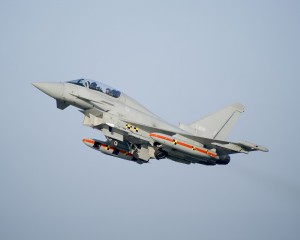
Italy has invested significantly in Meteor development and currently manufactures the seeker near Naples. It is clear that cost savings can be obtained from pooling resources for buying, stockpiling and maintaining a common weapons capability for the F-35A, F-35B and Eurofighter.
A key element of any rethink about the future of 21st century airpower is clearly working coalition investments and experiences more effectively in building out common capabilities and shaping greater interoperability for operations. The F-35 provides a unique integrated air combat capability whereby coalitions of joint or allied F-35s can be supported in common.
And linking F-35s with evolving overall joint and coalition combat force will be a key opportunity as well.
For Italy and the UK, as both F-35B operators, and Meteor partners, there is a clear opportunity to leverage joint experience and investments as well.
The UK is in a similar position with Italy (Eurofighter and F-35B operators), there is a natural partnership between the two in shaping a common policy with regard to Meteor integration on the F-35 and the residual ability to leverage the advantages from commonality.
Furthermore, this gives both the UK and Italy an increased operational edge and grants both nations a significant capability for coalition operations which could be leverage to enhance their political influence in those coalition operations.
UK and Italian leadership on Meteor would also act as a catalyst towards other JSF users interested in this capability. It is a case of each country’s natural alliances reinforcing the others.
There are also broader industrial benefits worth considering as well. It is clear that the global F-35 enterprise draws upon a global supply chain; what is not fully realized is that next generation weaponization can both benefit from the F-35 global enterprise and empower legacy aircraft at the same time.
With regard to Italy, Meteor’s integration on both F-35 and Eurofighter offers the opportunity to improve the overall Italian industrial return across the F-35 program and reinforces the investment plan for the Final Assembly and Check Out (FACO) facility; expanding the FACO’s role to include the weapon aspects of sustainment is fully in keeping with the vision for a Regional Support Center as clearly articulated by the Italian Government.
In short, developing new weapons for combat aircraft is clearly a core necessity moving forward.
There are clearly major advantages to working commonality across the airfleet, and ensuring that the F-35 is the enabler for the overall weapons enterprise.
The Eurofighter and F-35 sharing the benefits of a next generation missile like the Meteor can enhance as well ways to ensure that these two aircraft work seamlessly across the battlespace for 21st century operations.
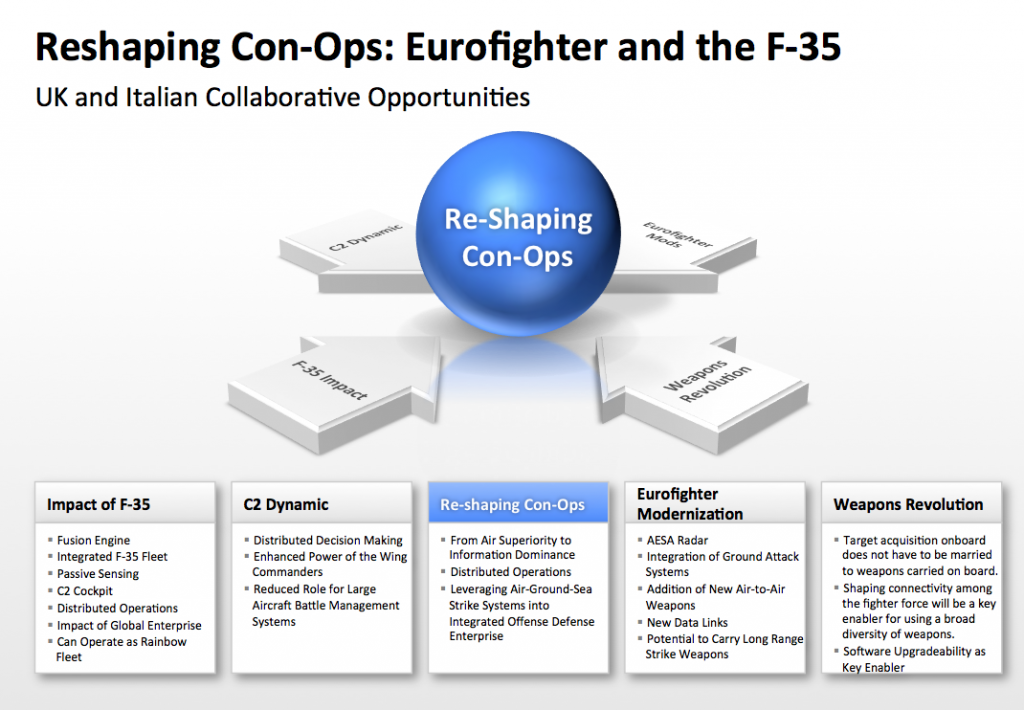
For additional looks at the Eurofighter and F-35 dynamics see the following:
https://www.rusi.org/publications/defencesystems/ref:A540F4BD801C1E/#.VGYeCZPF9OE
http://aviationweek.com/farnborough-2014/uk-gears-typhoon-enhancements
http://aviationweek.com/awin/uk-evaluates-future-fighter-weapons-sensors

